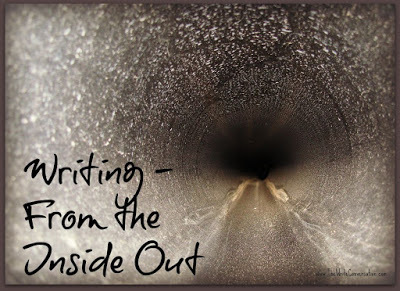Writing From the Inside Out
by Katy Kauffman @KatyKauffman28
 I hardly ever cry at movies. I cried at the end of Inside Out. Even though it’s a kids’ movie, I saw how the inside of our brains might work when anger, fear, disgust, sadness, or joy takes the helm.
I hardly ever cry at movies. I cried at the end of Inside Out. Even though it’s a kids’ movie, I saw how the inside of our brains might work when anger, fear, disgust, sadness, or joy takes the helm.
Each feeling was embodied in a little colored creature whose outward appearance matched its personality. Short, blue Sadness couldn’t help but be drawn to sad things and turn the little girl’s memories blue (or sad), while tall, cheerful Joy tried to keep Sadness distracted and in check.
At the end (I won’t give it away), I felt what the characters felt and knew firsthand the feelings that were being portrayed on screen. I had lived them. From the inside out.
When we write, we want to impact the reader from the inside out. We want them to relate to what we’re saying—that we understand the struggles they’re facing because we’ve been there or know of someone who has. That we know of a solution and it has worked for us or a loved one. We want the reader to feel like we’re in the boat with them instead of on shore yelling at them. An effective book, devotion, or article is written from the inside out.
We want them to relate to what we’re saying—that we understand the struggles they’re facing because we’ve been there or know of someone who has. That we know of a solution and it has worked for us or a loved one. We want the reader to feel like we’re in the boat with them instead of on shore yelling at them. An effective book, devotion, or article is written from the inside out.
We can tackle a topic two ways: from the outside looking in or from the inside looking out. A reader will be able to tell when we’re trying to talk about a subject that we don’t have much knowledge in. They may appreciate our effort, but our message will lose some of its effectiveness. But if we share about something that we’ve lived or have closely observed, then we can write about it with insight, feeling, and persuasion. Consider the difference between these two opening lines for a book about peace:
In the middle of a storm, you can find peace in God.
That’s true. But read the line amplified below, and see if you think the author has lived what she’s writing.
 In the middle of a storm that makes you question your certainty of the truth, that tests your resolve every day, and that causes you to cry out to God, you can find in Him a peace that will calm your heart, renew your strength, and guide you safely through.
In the middle of a storm that makes you question your certainty of the truth, that tests your resolve every day, and that causes you to cry out to God, you can find in Him a peace that will calm your heart, renew your strength, and guide you safely through.
In the second line, do you think the author is writing from the inside out? Can you hear the desperation in her voice as she describes the storm? We don’t want to be too dramatic or showy when we write, but we can show that we’ve been there. In the storm. In the victory. In the growing up process. Because the author writes about the specifics of the storm, would you take her at her word that the peace she describes is possible? Perhaps she has lived it. We don’t have to give more detail about our lives than is appropriate, but perhaps God wants us to use our story—our ups and downs, struggles and victories—to help someone who is traveling a similar road.
In the years that I wrote both of my Bible studies, I needed the principles I was studying. They became lifeto me, an empowering source for victory. As I embark in writing my third Bible study, I need this book, too. I need to learn from the book of Nehemiah how to walk in strength and to sustain joy when the enemy is doing his best to destroy my strength and joy. I pray that what I learn from Nehemiah will bless other’s people hearts to fortify their strength and renew their joy as well.
What you learn doesn’t have to stop with you. It can be passed to others (2 Timothy 2:2). What has God taught you that would bless someone else’s life? What is He leading you to write about? How can you encourage someone else and still guard your family’s privacy and your own? May God lead you to write from the inside out and pass along the treasures that have enriched your life.
Tell us below what treasures God has taught you. What have you learned from the “inside out”? Join the conversation!
TWEETABLE#Writing from the Inside Out - Insight from author @KatyKauffman28 on @EdieMelson (Click to Tweet)
 Katy Kauffman is an award-winning writer and a co-founder of Lighthouse Bible Studies, a ministry which seeks to connect people to God through His Word. She has taught the Bible to women and teens, and has two published Bible studies for women, 2 Timothy: Winning the Victory and Faith, Courage, and Victory. Her heart’s desire is for women to know and love God, understand the richness of His Word, and fulfill His plan for their lives. Katy is also the designer of Broken but Priceless: The Magazine. She makes her home near Atlanta, Georgia. Connect with her further on Facebook and Twitter.
Katy Kauffman is an award-winning writer and a co-founder of Lighthouse Bible Studies, a ministry which seeks to connect people to God through His Word. She has taught the Bible to women and teens, and has two published Bible studies for women, 2 Timothy: Winning the Victory and Faith, Courage, and Victory. Her heart’s desire is for women to know and love God, understand the richness of His Word, and fulfill His plan for their lives. Katy is also the designer of Broken but Priceless: The Magazine. She makes her home near Atlanta, Georgia. Connect with her further on Facebook and Twitter.
 I hardly ever cry at movies. I cried at the end of Inside Out. Even though it’s a kids’ movie, I saw how the inside of our brains might work when anger, fear, disgust, sadness, or joy takes the helm.
I hardly ever cry at movies. I cried at the end of Inside Out. Even though it’s a kids’ movie, I saw how the inside of our brains might work when anger, fear, disgust, sadness, or joy takes the helm. Each feeling was embodied in a little colored creature whose outward appearance matched its personality. Short, blue Sadness couldn’t help but be drawn to sad things and turn the little girl’s memories blue (or sad), while tall, cheerful Joy tried to keep Sadness distracted and in check.
At the end (I won’t give it away), I felt what the characters felt and knew firsthand the feelings that were being portrayed on screen. I had lived them. From the inside out.
When we write, we want to impact the reader from the inside out.
 We want them to relate to what we’re saying—that we understand the struggles they’re facing because we’ve been there or know of someone who has. That we know of a solution and it has worked for us or a loved one. We want the reader to feel like we’re in the boat with them instead of on shore yelling at them. An effective book, devotion, or article is written from the inside out.
We want them to relate to what we’re saying—that we understand the struggles they’re facing because we’ve been there or know of someone who has. That we know of a solution and it has worked for us or a loved one. We want the reader to feel like we’re in the boat with them instead of on shore yelling at them. An effective book, devotion, or article is written from the inside out.We can tackle a topic two ways: from the outside looking in or from the inside looking out. A reader will be able to tell when we’re trying to talk about a subject that we don’t have much knowledge in. They may appreciate our effort, but our message will lose some of its effectiveness. But if we share about something that we’ve lived or have closely observed, then we can write about it with insight, feeling, and persuasion. Consider the difference between these two opening lines for a book about peace:
In the middle of a storm, you can find peace in God.
That’s true. But read the line amplified below, and see if you think the author has lived what she’s writing.
 In the middle of a storm that makes you question your certainty of the truth, that tests your resolve every day, and that causes you to cry out to God, you can find in Him a peace that will calm your heart, renew your strength, and guide you safely through.
In the middle of a storm that makes you question your certainty of the truth, that tests your resolve every day, and that causes you to cry out to God, you can find in Him a peace that will calm your heart, renew your strength, and guide you safely through. In the second line, do you think the author is writing from the inside out? Can you hear the desperation in her voice as she describes the storm? We don’t want to be too dramatic or showy when we write, but we can show that we’ve been there. In the storm. In the victory. In the growing up process. Because the author writes about the specifics of the storm, would you take her at her word that the peace she describes is possible? Perhaps she has lived it. We don’t have to give more detail about our lives than is appropriate, but perhaps God wants us to use our story—our ups and downs, struggles and victories—to help someone who is traveling a similar road.
In the years that I wrote both of my Bible studies, I needed the principles I was studying. They became lifeto me, an empowering source for victory. As I embark in writing my third Bible study, I need this book, too. I need to learn from the book of Nehemiah how to walk in strength and to sustain joy when the enemy is doing his best to destroy my strength and joy. I pray that what I learn from Nehemiah will bless other’s people hearts to fortify their strength and renew their joy as well.
What you learn doesn’t have to stop with you. It can be passed to others (2 Timothy 2:2). What has God taught you that would bless someone else’s life? What is He leading you to write about? How can you encourage someone else and still guard your family’s privacy and your own? May God lead you to write from the inside out and pass along the treasures that have enriched your life.
Tell us below what treasures God has taught you. What have you learned from the “inside out”? Join the conversation!
TWEETABLE#Writing from the Inside Out - Insight from author @KatyKauffman28 on @EdieMelson (Click to Tweet)
 Katy Kauffman is an award-winning writer and a co-founder of Lighthouse Bible Studies, a ministry which seeks to connect people to God through His Word. She has taught the Bible to women and teens, and has two published Bible studies for women, 2 Timothy: Winning the Victory and Faith, Courage, and Victory. Her heart’s desire is for women to know and love God, understand the richness of His Word, and fulfill His plan for their lives. Katy is also the designer of Broken but Priceless: The Magazine. She makes her home near Atlanta, Georgia. Connect with her further on Facebook and Twitter.
Katy Kauffman is an award-winning writer and a co-founder of Lighthouse Bible Studies, a ministry which seeks to connect people to God through His Word. She has taught the Bible to women and teens, and has two published Bible studies for women, 2 Timothy: Winning the Victory and Faith, Courage, and Victory. Her heart’s desire is for women to know and love God, understand the richness of His Word, and fulfill His plan for their lives. Katy is also the designer of Broken but Priceless: The Magazine. She makes her home near Atlanta, Georgia. Connect with her further on Facebook and Twitter.
Published on August 19, 2015 01:00
No comments have been added yet.



